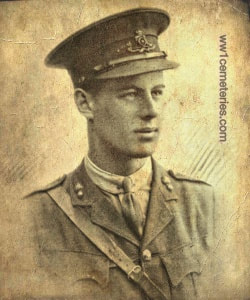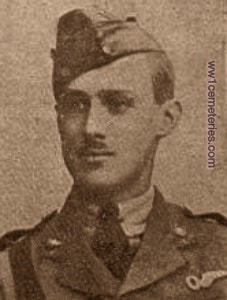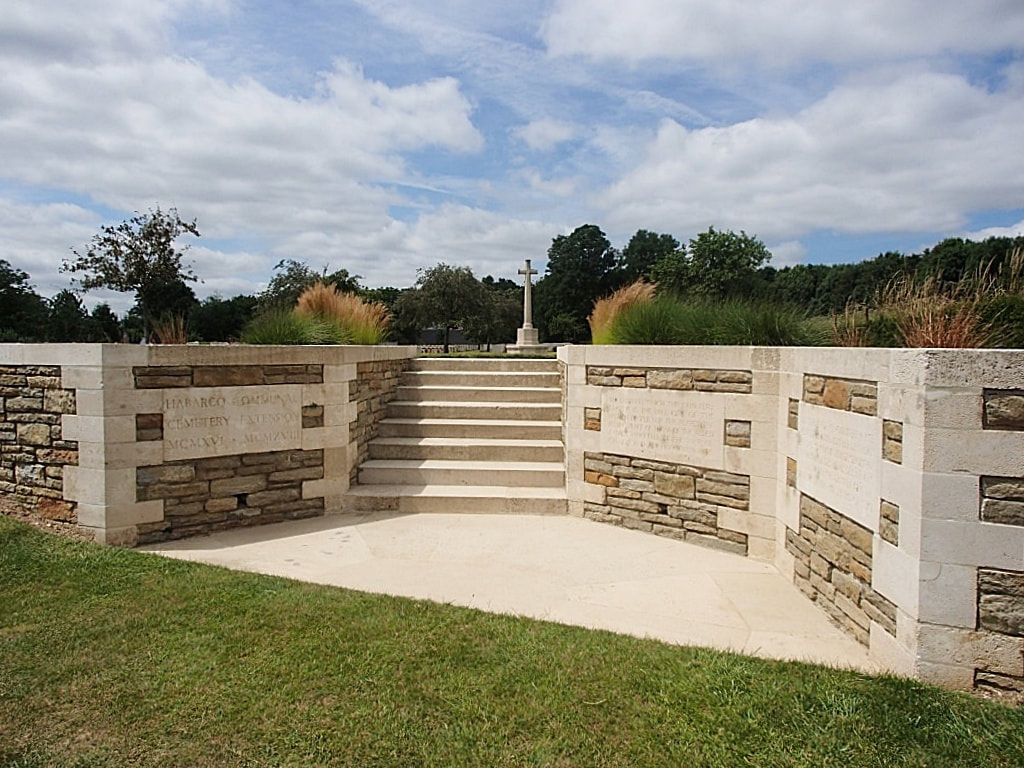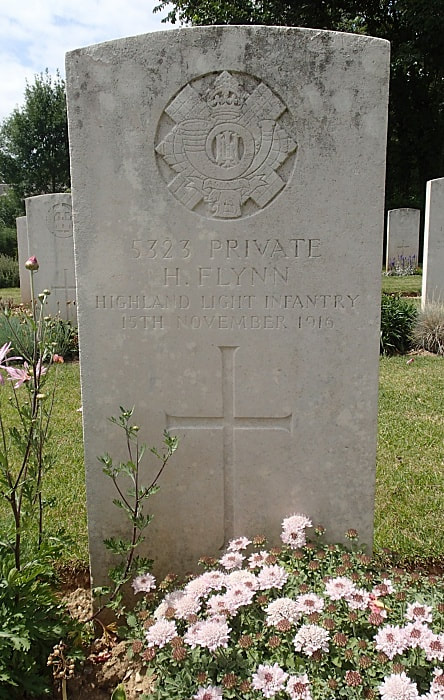HABARCQ COMMUNAL CEMETERY EXTENSION
Pas De Calais
France
GPS Coordinates Latitude: 50.30741 Longitude: 2.6163
Location Information
Habarcq is a village in the Department of the Pas-de-Calais, 12 kilometres west of Arras, a little south of the main Arras-St.Pol road.
The Communal Cemetery is on the north side of the village on the road to Haute-Avesnes (D61), and the Extension is on the north and west side of the Communal Cemetery.
Visiting Information
Wheelchair access to this site is possible, but maybe by alternative entrance.
Historical Information
The extension to the communal cemetery was begun by French troops in 1914 and was used by them until March 1916. Commonwealth forces (XVII Corps) then took over this part of the front and field ambulances continued to bury in the extension using the plots which are now numbered I, V and VIII. In March 1917, the extension was closed, except for two later burials in Plot V.
Habarcq Communal Cemetery Extension contains 179 Commonwealth burials of the 1914-1918 war. There are also 15 Commonwealth burials of the 1939-1945 war here, 11 of which are unidentified. There are also 378 French burials of the 1914-1918 war here.
Total Burials: 572.
Commonwealth World War One Identified Casualties: United Kingdom 171, South Africa 6, New Zealand 2. Total 179.
Commonwealth World War Two Identified Casualties: United Kingdom 4. Total 4.
The cemetery was designed by W H Cowlishaw

Second Lieutenant
Anthony Harvey Bowman
37th Bty. Royal Field Artillery
20th May 1916, aged 24.
Plot I. A. 2.
Son of Anthony Nichol Bowman and Laura Phoebe Bowman, of Carlisle; husband of Prudence Cheney Bowman (nee Bolton), of Oakbank Cottage, Wetheral, Carlisle.
His headstone bears the inscription; "He Is Sacred High In Our Memory And To God We Can Leave The Rest."
Anthony Harvey Bowman
37th Bty. Royal Field Artillery
20th May 1916, aged 24.
Plot I. A. 2.
Son of Anthony Nichol Bowman and Laura Phoebe Bowman, of Carlisle; husband of Prudence Cheney Bowman (nee Bolton), of Oakbank Cottage, Wetheral, Carlisle.
His headstone bears the inscription; "He Is Sacred High In Our Memory And To God We Can Leave The Rest."

Second Lieutenant
Francis Carey B. O. Clements
Cable Sect. attd. "F" Corps Signals Royal Engineers
11th January 1917, aged 24.
Plot VIII. J. 9.
Son of F. W. and Louise Clements, of "Halstead," Lansell Rd., Toorak, Melbourne, Australia. Was training for the profession of Electrical Engineer.
His headstone bears the inscription; "Beloved Son Of Francis And Louise Clements Melbourne, Australia."
Francis Carey B. O. Clements
Cable Sect. attd. "F" Corps Signals Royal Engineers
11th January 1917, aged 24.
Plot VIII. J. 9.
Son of F. W. and Louise Clements, of "Halstead," Lansell Rd., Toorak, Melbourne, Australia. Was training for the profession of Electrical Engineer.
His headstone bears the inscription; "Beloved Son Of Francis And Louise Clements Melbourne, Australia."

Second Lieutenant
George Allan Exley
29th Sqdn. Royal Flying Corps and 5th Bn. King's Own Yorkshire Light Infantry
14th January 1917, aged 23.
Plot VIII. H. 9.
Son of John and Mary E. Exley, of Farr Royd, Burley-in-Wharfedale, Leeds, Yorks.
His headstone bears the inscription; "Thou Hast Proved That The Purest Joy Is Duty." (Quote from a poem by Hartley Coleridge)
George Allan Exley
29th Sqdn. Royal Flying Corps and 5th Bn. King's Own Yorkshire Light Infantry
14th January 1917, aged 23.
Plot VIII. H. 9.
Son of John and Mary E. Exley, of Farr Royd, Burley-in-Wharfedale, Leeds, Yorks.
His headstone bears the inscription; "Thou Hast Proved That The Purest Joy Is Duty." (Quote from a poem by Hartley Coleridge)

4/1284 Serjeant
Thomas Richard Jones
Tunnelling Coy, New Zealand Engineers
14th November 1916, aged 36.
Plot VIII. B. 6.
Son of William and Hannah Jones, of Emmaville, Australia. Served in the South African Campaign.
Thomas Richard Jones
Tunnelling Coy, New Zealand Engineers
14th November 1916, aged 36.
Plot VIII. B. 6.
Son of William and Hannah Jones, of Emmaville, Australia. Served in the South African Campaign.

10009 Private
William Henry Tucker
1st Bn. Devonshire Regiment
9th June 1916, aged 19.
Plot I. E. 3.
Son of Henry and Sarah Ann Tucker, of 27, Quay Rd., Newton Abbot, Devon
"My grandma's favourite brother."
Picture courtesy of Mary Illing
William Henry Tucker
1st Bn. Devonshire Regiment
9th June 1916, aged 19.
Plot I. E. 3.
Son of Henry and Sarah Ann Tucker, of 27, Quay Rd., Newton Abbot, Devon
"My grandma's favourite brother."
Picture courtesy of Mary Illing
Shot at Dawn
5323 Private Hugh Flynn, 18th Bn. Highland Light Infantry, executed for desertion on 15th November 1916. Plot VIII. G. 7. Son of Mrs. Jane Todd, of 171, High St., Dumbarton.
He had volunteered in Apr 1915; & on 26 July 1916 when his battalion were in the trenches N of Maricourt, Flynn was found to be absent when the rations were issued. He was next seen at St Pol on 5 August.
At trial, the following account was given: at Auxi-le-Château on 5 Aug, Flynn had accosted another soldier, asking where he could join the Army, saying that he had stowed away on a boat from Folkestone. He explained that the Army uniform that he was wearing had been obtained in St Omer; & further, that if he could not join the Army in France, he would go to England from Boulogne. After some delay for investigation, he was returned to his unit on 19 Sept.
Flynn’s own account was to the effect that he remembered being in a trench during heavy shelling when his request to see the MO was refused, & that he could remember nothing else till he found himself in Corbie when he decided to join another regiment to make a fresh start.
His CO considered him a useless soldier, but suggested that he had not deliberately run away to avoid duty. The Brigade commander agreed with the suggestion, but the Divisional commander did not. The Corps commander suggested that Flynn’s known weakness under fire might amount to extenuating circumstances, but at the higher levels no sympathy was shown. (Corns, pp. 154-156)
5626 Private John McQuade, 18th Bn. Highland Light Infantry, executed for desertion on 6th November 1916. Plot VIII. J. 7.
He was attached to a Trench Mortar Battery as a shell carrier, when on 29 July 1916 he was warned for the trenches, but found to be missing when the battery fell in. McQuade was brought back to his battalion from Corbie on 5 Aug.
On 31 Aug, he fell out from the march, saying that he could go no further, & was thus missing from the evening roll-call at Sus St Léger. On 10 Sept, McQuade & another soldier reported to the MP at Fontinettes, saying that he wanted to get to his machine-gun unit at Camiers. As he had no movement order, he was arrested & returned to his unit the next day.
At trial at Arras, he was unrepresented, & scarcely defended himself — except to say in relation to the second charge of desertion that he had suffered from sore feet. It emerged that he had gone missing from his draft (he had enlisted in May 1915) between Boulogne & Etaples; & that on 5 July 1916 he had been sentenced for Disobedience to 12 months’ imprisonment with hard labour, suspended — thus enabling him to return to duty.
His CO considered him as absolutely useless as a soldier, with nil fighting qualities, & a perpetual nuisance — who had originally been left behind when the battalion came to France.
The first charge of desertion had to be re-tried, resulting in a conviction only for absence, but the death sentence stood, as did the similar sentence on the second charge. (Corns, pp.156-157)
5323 Private Hugh Flynn, 18th Bn. Highland Light Infantry, executed for desertion on 15th November 1916. Plot VIII. G. 7. Son of Mrs. Jane Todd, of 171, High St., Dumbarton.
He had volunteered in Apr 1915; & on 26 July 1916 when his battalion were in the trenches N of Maricourt, Flynn was found to be absent when the rations were issued. He was next seen at St Pol on 5 August.
At trial, the following account was given: at Auxi-le-Château on 5 Aug, Flynn had accosted another soldier, asking where he could join the Army, saying that he had stowed away on a boat from Folkestone. He explained that the Army uniform that he was wearing had been obtained in St Omer; & further, that if he could not join the Army in France, he would go to England from Boulogne. After some delay for investigation, he was returned to his unit on 19 Sept.
Flynn’s own account was to the effect that he remembered being in a trench during heavy shelling when his request to see the MO was refused, & that he could remember nothing else till he found himself in Corbie when he decided to join another regiment to make a fresh start.
His CO considered him a useless soldier, but suggested that he had not deliberately run away to avoid duty. The Brigade commander agreed with the suggestion, but the Divisional commander did not. The Corps commander suggested that Flynn’s known weakness under fire might amount to extenuating circumstances, but at the higher levels no sympathy was shown. (Corns, pp. 154-156)
5626 Private John McQuade, 18th Bn. Highland Light Infantry, executed for desertion on 6th November 1916. Plot VIII. J. 7.
He was attached to a Trench Mortar Battery as a shell carrier, when on 29 July 1916 he was warned for the trenches, but found to be missing when the battery fell in. McQuade was brought back to his battalion from Corbie on 5 Aug.
On 31 Aug, he fell out from the march, saying that he could go no further, & was thus missing from the evening roll-call at Sus St Léger. On 10 Sept, McQuade & another soldier reported to the MP at Fontinettes, saying that he wanted to get to his machine-gun unit at Camiers. As he had no movement order, he was arrested & returned to his unit the next day.
At trial at Arras, he was unrepresented, & scarcely defended himself — except to say in relation to the second charge of desertion that he had suffered from sore feet. It emerged that he had gone missing from his draft (he had enlisted in May 1915) between Boulogne & Etaples; & that on 5 July 1916 he had been sentenced for Disobedience to 12 months’ imprisonment with hard labour, suspended — thus enabling him to return to duty.
His CO considered him as absolutely useless as a soldier, with nil fighting qualities, & a perpetual nuisance — who had originally been left behind when the battalion came to France.
The first charge of desertion had to be re-tried, resulting in a conviction only for absence, but the death sentence stood, as did the similar sentence on the second charge. (Corns, pp.156-157)





































